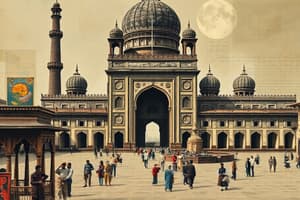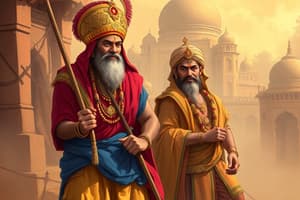Podcast
Questions and Answers
Who established the Delhi Sultanate's golden age in the mid-14th century?
Who established the Delhi Sultanate's golden age in the mid-14th century?
- Amir Khusrau
- Fakhruddin Mubarak Shah
- Muhammad of Ghor
- Alauddin Khalji (correct)
Which architectural structures exemplify the fusion of Persian, Hindu, and Buddhist styles during the Delhi Sultanate?
Which architectural structures exemplify the fusion of Persian, Hindu, and Buddhist styles during the Delhi Sultanate?
- Qutb Minar and Tughlaqabad Fort (correct)
- Charminar and Gol Gumbaz
- Taj Mahal and Hawa Mahal
- Red Fort and Lotus Temple
What led to the decline of the Delhi Sultanate?
What led to the decline of the Delhi Sultanate?
- Invasion by the Marathas
- Establishment of the Vijayanagara Empire in the north (correct)
- Conquest by European colonial powers
- Rise of the Mughal Empire in the south
Which dynasty came after the Khaljis in ruling the Delhi Sultanate?
Which dynasty came after the Khaljis in ruling the Delhi Sultanate?
What were the hallmarks of the Delhi Sultanate's governance?
What were the hallmarks of the Delhi Sultanate's governance?
What led to the ultimate collapse of the Delhi Sultanate in the 16th century?
What led to the ultimate collapse of the Delhi Sultanate in the 16th century?
How did the Delhi Sultanate adapt its administrative systems to local Indian conditions?
How did the Delhi Sultanate adapt its administrative systems to local Indian conditions?
Flashcards are hidden until you start studying
Study Notes
The Delhi Sultanate: A Tapestry of Founders, Culture, Expansion, and Administration
The Delhi Sultanate, which flourished from the 13th to the 16th century, heralded the dawn of Muslim rule in the Indian subcontinent. Though fleeting, this era left an indelible mark on the region's history and culture.
Founders and Origins
The Delhi Sultanate's roots trace back to the invasion of India by Muhammad of Ghor in 1175. After his death, a series of Turkic and Afghan dynasties would rise to power. The Khaljis, led by Alauddin Khalji, established the Sultanate's golden age in the mid-14th century, setting the stage for the ensuing Tughlaq, Sayyid, and Lodhi dynasties.
Culture and Society
The Delhi Sultanate brought a diverse mix of cultures and ideas to India. Persian and Turkic customs mingled with native Hindu and Buddhist practices, resulting in a rich, multi-faceted society. Sultanate architecture, exemplified by the Qutb Minar and Tughlaqabad Fort, showcased a fusion of Persian, Hindu, and Buddhist styles. The Sultanate also fostered a vibrant Islamic intellectual culture, producing scholars like Fakhruddin Mubarak Shah and Amir Khusrau, who enriched the world with their poetry and prose.
Decline and Collapse
The Delhi Sultanate's decline began with the rise of the Vijayanagara Empire in the south and the establishment of the Mughal Empire in the north. Political instability, economic mismanagement, and rebellions weakened the Sultanate's rule, paving the way for its ultimate collapse in the 16th century.
Expansion and Administrative Systems
In its heyday, the Delhi Sultanate stretched from the Punjab to Bengal and included modern-day Uttar Pradesh, Bihar, and Madhya Pradesh. The Sultanate's administrative systems were based on Persian models, adapting to fit local Indian conditions. Centralized bureaucracies, provincial governorships, and military conquests were hallmarks of the Sultanate's governance.
Conclusion
The Delhi Sultanate, though short-lived, left a profound and lasting impact on India's history and culture. Its legacy can still be seen in modern India's diverse architecture, rich literary traditions, and administrative systems. The Sultanate served as a bridge between India's past and present, fostering an era of cultural exchange and intellectual prosperity that would shape the region's future.
Studying That Suits You
Use AI to generate personalized quizzes and flashcards to suit your learning preferences.




